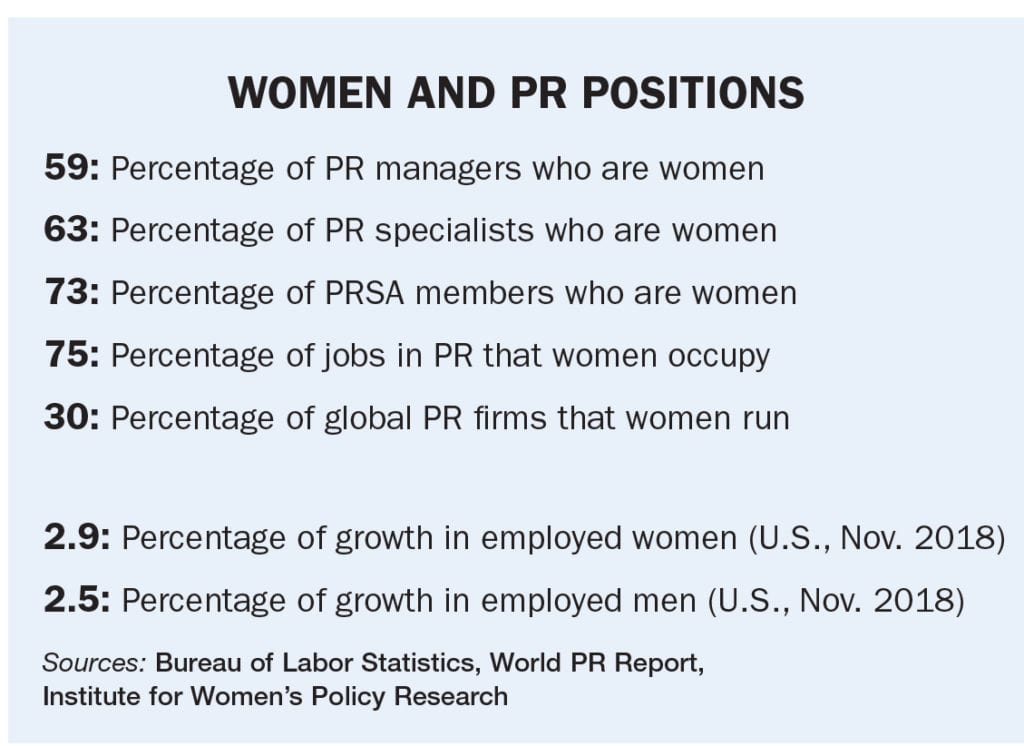
It’s long been known that in terms of numbers, women dominate the PR industry. In the U.S., women make up 60-80 percent of the industry’s workforce. Yet they occupy just one in five senior positions, according to a variety of sources. Globally, only about 30% of the C-Suites of PR agencies feature a woman in the top chair.
As Ruder Finn CEO Kathy Bloomgarden notes below, the lack of female CEOs is not a problem exclusive to PR. In 2017, just 4.8 percent of CEOs at Fortune 500 companies were women, the Pew Research Center says. As recently as 1995 there were no female CEOs at Fortune 500 companies. The low number of women directing films in Hollywood is appalling.
Talk But Not Enough Action
A McKinsey study from 2018 says more than 75% of CEOs include gender equality in their top 10 business priorities, yet the bulk of promotions go to men.
Men are promoted at 30% higher rates than women during their early career stages, McKinsey research shows. In addition, entry-level women are significantly more likely than men to have spent five or more years in the same role.
Better news comes from board composition. The share of women on boards of Fortune 500 companies has more than doubled, from 9.6% in 1995 to 22.2% in 2017, Pew says.
The Pay Gap
Other issues include the pay gap between men and women, which is well known. In the U.S., women earn about 75-82 cents on the dollar that men make. The wage gap between the sexes in PR is estimated at $5,000-$6,000.
The wage gap is an issue within and outside PR, of course. Studying men and women who stayed in their jobs for an extended period, the ADP Research Institute found that women, on average, are paid 17 percent ($15,000) less in base salary than men.
The statistics are even less encouraging when looking at ethnic minorities. Pew says among full- and part-time workers in the U.S., blacks earned just 75% as much as whites in median hourly earnings. Most statistics show white men out-earn minority group males and, as you’d expect, they make more than women of all ethnicities.
As we get ready to celebrate PR News’ Top Women in PR (January 25, 2019, NYC), we asked several Top Women honorees to assess the state of women in PR. We also asked about what can be done to improve the condition of women in the industry. Their edited responses follow.
 Lina Baena
Lina Baena
Group VP, Public Relations
CCOM Group
These are great times for women in PR and marketing. Women have the opportunity to be the driving force and take leadership positions. Companies are recognizing and promoting individuals based on their talent and communication and professional skills, instead of gender.
Nothing is more inspiring than seeing how women in the industry are pioneering, willing to take risks and are coming up with innovative ways to reach and influence the right audiences while taking their clients to the next level.
Something that I admire about women in our industry is how we support one another and continue evolving. I am a firm believer in the power of mentorship. When I began my career, I had a great leader who guided me. Now, it is my professional responsibility to empower and guide the next generation of women in PR.
There are several ways that the role of women in PR can be enhanced, including:
Becoming part of and supporting organizations that help form communities of women who can learn from each other, contribute to each other’s success and advance their careers.
Enhancing female PR pros by giving them a voice and ensuring that they are part of key speaking opportunities at trade events and forums. Sharing success stories and career paths is a great way to inspire others.
As a result of the social media phenomenon, PR has undergone drastic changes. It is imperative for PR pros to stay ahead of the curve in a digitally savvy world. Continue to learn, familiarize and adapt as the industry evolves.
Support industry awards and recognitions that provide the opportunity to showcase the fruits of hard work and determination.
 Kathy Bloomgarden
Kathy Bloomgarden
CEO
Ruder Finn
While our industry is probably one of the most accepting and inclusive of women generally, we are falling short when it comes to the presence of women in leadership roles and at the executive level.
When we look at sheer numbers, women comprise nearly 75% of the jobs in PR. Yet women occupy approximately 20% of the senior leadership positions. Further, women run 30% of all global PR agencies. I am proud to be one of them!
This is not a PR-only issue: just 4.8% of Fortune 500 companies have female CEOs. This is so even though it has been proven repeatedly that companies with diverse and inclusive management teams outperform those that don’t.
Where we as an industry can do better is to look at how to embrace female leadership. Creating a respectful workplace, offering mentorship and guidance, fair pay and benefits and an overall positive culture that encourages diversity of experience will encourage female leaders.
 Anita Brikman
Anita Brikman
SVP, Communications & Public Affairs
Consumer Healthcare Products Association
Executive Director, CHPA Educational Foundation
We have advanced in one sense: everywhere you look in PR and marketing there are many women. They’re consulting for agencies, building big brands, or working at in-house departments. Women are the majority.
But we’re lagging in another sense: we need more women in senior leadership roles and sitting in the C-Suite. I want to see an equal number of women rise to the top spots on these teams; that would be real advancement.
Companies need to actively identify and invest in women PR leaders. That means making a formal and visible commitment to equal pay, investing in leadership development specifically for women, and encouraging mentorship programs where men and women can learn from each other.
We all have something to teach and share, which can build alliances, break down gender barriers, and broaden everyone’s skills.
 Lorri Christou
Lorri Christou
VP, External Communications & PR
Choice Hotels International
Progress has been made, but not enough. Despite PR being a field that’s female-dominated, men still hold a disproportionate number of leadership positions. Women need to pursue opportunities at the highest levels of corporate America, including the C-Suite and the boardroom.
More important, a diverse workforce creates diversity of thought and perspective, which leads to business results. Companies in the top quartile for gender diversity are 21 percent more likely to have financial returns above their respective national industry medians, according to McKinsey.
PR pros are experts in understanding an audience and positioning ideas accordingly, which are skills we must apply toward advancing our profession in the eyes of executive leadership.
If you are not at the table, I’d encourage every female PR leader to master the art of translating their value to the C-Suite in language it understands: hard metrics that drive business goals. The business value of a financial or legal consultant is not different than that of a communications professional—our expertise is just as vital to the bottom line.

 Nicole Dye-Anderson
Nicole Dye-Anderson
AVP, Media Relations
Barclays
Definitely I’ve seen growth in my 20+ years in the field, but there’s much that still needs to be done. One advancement I’d like to see continue, and I say continue because I’ve seen progress, is the role of women in leadership. The good news is we’re on the right path. I spoke on a panel recently that was not about women; it was about influencer marketing. Still, it was an all-woman panel and its members were in leadership positions.
At Barclays we’ve got a U.N.-sponsored campaign called HeForShe, which advocates for gender equality. It’s a voluntary program and includes a lot of our male leadership…who understand that there’s a leadership gap. They partner with or sponsor our rising stars, who happen to be women. The goal is to encourage all sexes to be agents of change and, for example, call out negative stereotypes and behaviors, such as mansplaining. Male sponsors are extremely important in this and I know Barclays prides itself on having the HeForShe program. It is a small piece, though.
We as women have a responsibility to speak up and seek leadership positions. Sometimes it’s you have not, because you ask not. For me it’s seeking out leadership positions, particularly thought-leadership positions. So it could be speaking opportunities or board positions or being the first to raise your hand to volunteer to lead something. We also have to speak up for one another and make sure we’re in the right companies that foster an environment to do so.
 Laurie Goldberg
Laurie Goldberg
Group EVP, Public Relations
Discovery and Science Channel
In my years I’ve seen a lot of progress for women in PR and communications. I’ve been doing this for a very long time. When I started, there were probably more men in PR than women.
At Discovery I’ve been treated very fairly in terms of pay and promotion. I realize one argument is that women aren’t promoted to the top jobs in PR. I feel it’s quite the opposite here and in television generally. Women hold nearly all the top PR jobs here. I’ve been very, very lucky, I guess.
When I was in sports PR, I think I saw a bit of that [women failing to get top positions]. But women are good communicators and I think PR is a profession where you have to be humble. You’re basically asking—some would say begging—people to cover your stories. And you’re dealing with talent. You have to multitask. There are some men who are great multitaskers, but I think historically women are credited with being very good at it. PR is such as multitasking profession, it makes sense that so many women are in senior roles.
 Caroline Guscott
Caroline Guscott
Director, Communications and External Relations
The Cleveland Museum of Art
By sheer determination to share our talent and be key contributors to successful workplaces, women continue to gain a more impactful presence across all disciplines and industries. There remains, however, ample opportunity to increase diversity in the highest decision-making positions. With voices that help shape the global narrative, the PR/marketing community has an obligation to embrace a leadership position and be a champion of equity and inclusion.
This may be achieved by establishing unequivocal standards and practices in the field that eliminate barriers, such as equal pay and representation in the C-Suite for women.
If we, as PR/marketing professionals, aim to achieve the best results for those we serve, it is essential we seek out and offer a platform for fresh perspectives, including women, which reflect and represent our country’s growing diverse population.
 Gabrielle Jasinski
Gabrielle Jasinski
VP
Bospar
Women are continuing to advance in PR, but there is room for improvement. I’d like to see more women in leadership roles, more flexibility in work/life balance and equal pay throughout the industry.
To enhance the role of women in communications there must be widespread acceptance in the industry of diversity. Not only should women professionals be widely accepted; everyone should be accepted, regardless of age, race and sexual orientation.
Agencies should be offering more flexibility for women who need to balance work and childcare. Many of my coworkers are working moms who have enjoyed paid maternity leave and flexible hours to raise their children.
Women seem to thrive in meritocracies. This is certainly true in technology, where the key to success is what you know, not whom you know.
The role of women in PR can be enhanced through self-promotion. Ask for a promotion and a pay increase after a job well done. You are your best advocate.
 Anitra Marsh
Anitra Marsh
Associate Director, Global Communications
Procter & Gamble
I think we need more women in marketing and PR leadership positions–especially in the beauty industry where I work. Of the top 10 beauty companies in the world, only one, P&G Beauty, has a woman CEO, Alex Keith. The irony is that women are the biggest consumers of beauty products–yet we are typically not leading the biggest companies. This shows that the industry still has a ways to go in advancing more women to leadership positions.
First, I think it’s essential that women be given unique and challenging leadership opportunities early in their career and that it be comparable to their male peers. That breadth and depth of experience early on is essential to becoming a top pick for future, higher-level leadership positions.
Second, I think it’s incumbent upon men and women to advocate for women in PR. Progress cannot happen if only women see the value of gender diversity in leadership.
I’m proud of the fact that at P&G, 50% of our vice presidents in PR and communications are women and 50% are men. Those numbers can change quickly, so it requires sustained intentionality and support to maintain equality, but we are making progress.
Third, we must not fall into the trap of viewing women, or any group of people, as monolithic. We come from different backgrounds and cultures and have various life experiences. Having that diversity of culture, experience, and background reflected among women within an organization is critical to reap the reward of diversity.
 Sukhi Sahni
Sukhi Sahni
Director, Corporate Communications, U.S. Card
Capital One
I’ve been in the industry for almost two decades. There’s been constant growth in terms of women in our organization within the field of communications. It’s a reflection of the new world that we live in, where women are a lot more at the leading edge of technology. And communications is not what it was a couple of years ago. Typically as a communications professional you needed a communications degree to get into PR. Today you have communicators with degrees in research or data analytics. This reflects changes in the media landscape and how you need to communicate to consumers.
So, overall, there’s definitely been growth in women in communications and we’re reaching a point where women can have more influence on decision-making. There’s also been growth in respect for the field of communications, especially PR and the impact it can have on a brand.
For women to rise in the profession there are a few ideas I follow:
Learn Constantly: You need to be learning all the time, always being at the cutting edge of innovation and technology. It’s important to always be looking for trends and what’s going to happen next, and then trying to figure out how to stay ahead of that. An example is the different ways we can break through to the consumer during a time where the environment is so busy and there’s fake news out there. You have to be really smart about the tools you use and what you have at your disposal. It’s important to have a network of people you can learn from and exchange opinions.
Increase Your Influence: The goal is to be able to influence decision-making at every level of the organization. You can be an excellent professional and have great writing skills, but if you don’t know how to navigate the organization it will be hard to get a seat at the table and convince people of the value of PR and communications in general. I’d even say being able to influence the conversation is more important than having superior skills.
Mentoring: It’s important to be in an organization that has a culture that allows you to mentor the next-generation of leaders. We do that really well here and it’s why I’m still here after eight years. One of my favorite quotes is from Tom Peters: “True leaders don’t create followers, they create more leaders.” We live and breathe that here.
 Esther-Mireya Tejeda
Esther-Mireya Tejeda
Head of Corporate Communications & PR
Entercom
As both a woman and a person of color, I am committed to championing diversity at the highest levels of strategy and decision-making. It is simply not enough to be in the room. Women need a seat at the table. As communications leaders, often we are the gatekeepers charged with safeguarding and assessing the tone, content and context of the stories our brands are telling. If the people at the table do not reflect the diversity of thought, experience, and background that exists in the world, then we are failing before we begin.
As women, and as a woman of color in particular, it is critical to champion for the work we do and our contributions to the discipline and to fight for representation and influence whenever and wherever strategic decisions are being made.
 Duyen 'Jen' Truong
Duyen 'Jen' Truong
VP, Public Relations
Sage Communications
The battle for women to advance in PR/marketing continues to be hard fought. It won’t end until we can unequivocally say that there is equality in pay and growth opportunities. While women dominate our field, the numbers of women run smaller the higher up you go. This is so especially in larger organizations and in more technical industries, such as technology. We need to level the playing field everywhere before we can start counting wins.
The solution doesn’t start and stop with doing more to empower women. It lies in a holistic approach to incorporate diverse voices, cultures, experiences, backgrounds and personality types. This means not letting culture-fit bias or the squeaky wheel limit whom we empower. It means overcoming blind spots by inviting those who underestimate their abilities to be part of the solution. And it means having policies that promote work-life balance and a company ethos of diversity and equality.
 Darcy Brito
Darcy Brito
Business Manager, PR
Aflac
I think there is still work to be done on closing the disparity gap among women and minorities. While women predominantly represent the PR workforce, there is a significant shortage of them at the top – just 30 percent. Minority representation in the industry also remains skewed with 7.8 percent Black/African-American, 3.2 percent Asian and 3.7 percent Hispanic according to the Bureau of Labor Statistics.
We must be strategic in our efforts and purposeful as we work toward advancing women, including female minorities, to leadership. We will look to trailblazers like Karen van Bergen, CEO of Omnicom Public Relations Group, Catherine Hernandez-Blades, chief brand and communications officer at Aflac, and Rosemary Mercedes, EVP and CCO for Univision Communications Inc., as they pave the way for the next generation of mavericks.
There are several ways women can improve their standing in the industry:
A rising tide lifts all boats: It is important for women to be part of organizations that are diverse and inclusive. A culture that fosters collaboration among all employees can drive great results.
Believe in yourself: Embrace your successes and learn from your failures. Don’t be afraid to share your opinion. You are in the room for a reason - your unique perspective and achievements.
Don’t be the same, be better: Mentors are invaluable to one’s personal and professional growth. A mentor can serve as a sounding board and help avoid pitfalls from the impostor syndrome, which is a perception, that many women feel that they don’t deserve their success.
NOTE: A version of this content appeared originally in PR News, January, 5, 2019. For subscription information, please visit: http://www.prnewsonline.com/about/info
The Top Women in PR Awards luncheon was held Jan. 25, 2019, in NYC. You can see coverage here.
CONTACT: lina@ccomgroupinc.com coles@ruderfinn.com abrikman@chpa.org ndyeanderson@barclaycardus.com laurie_goldberg@discovery.com caguscott@gmail.com DBrito@aflac.com gabrielle@bospar.com lorri.christou@choicehotels.com marsh.ac.2@pg.com sukhi.sahni@capitalone.com esther-mireya.tejeda@entercom.com dtruong@aboutsage.com
